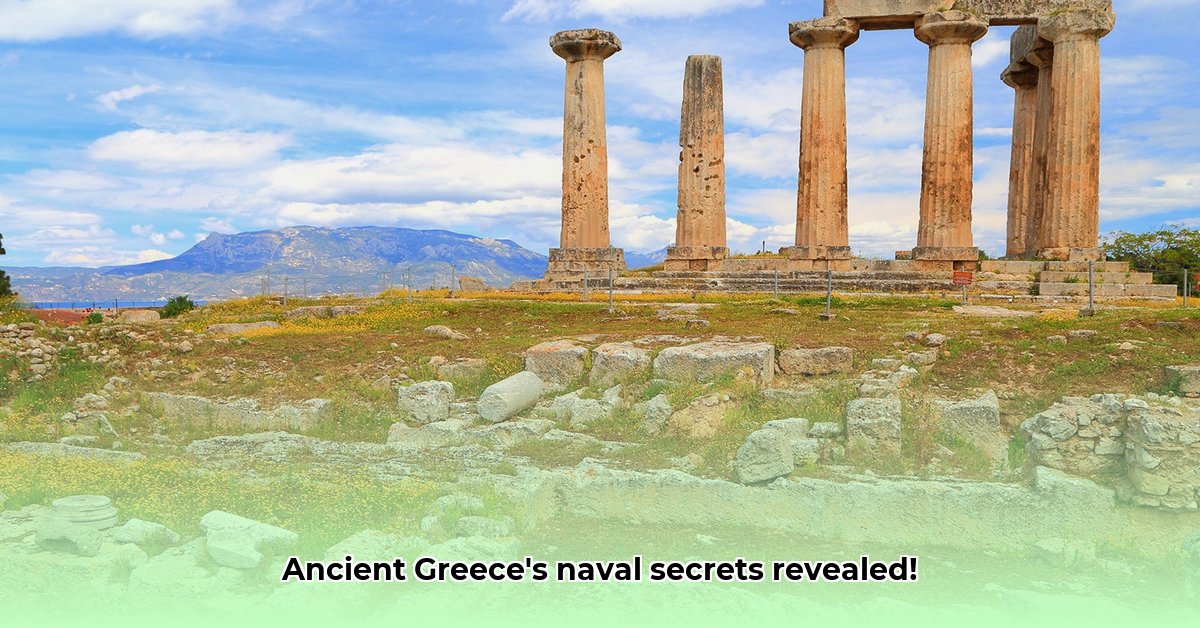Imagine a world where the sway of empires was determined by naval supremacy and the unpredictable nature of the seas – this was ancient Greece. Their ships were not mere vessels but embodiments of their power, vehicles of commerce, and emissaries of cultural influence. They were the linchpin for both expansion and defense. For a visual representation of this era, check out this Ancient Greece map. Prepare to embark on a detailed exploration of these seafaring innovations, from the versatile penteconters that navigated the Aegean to the mighty triremes that secured decisive victories. We will examine their construction, the artisans who built them, and the ingenious tactics that made their navies nearly invincible. We will also explore their limitations, acknowledging that even the most remarkable inventions are not without their vulnerabilities.
Ancient Greece Ships: Masters of the Mediterranean Naval Warfare
Envision yourself in the Aegean Sea around 700 BC. Instead of massive battleships, smaller, more agile vessels plied the waters: the penteconters. Think of them as the pickup trucks of the ancient world – the reliable workhorses of their time. Propelled by fifty rowers on a single level, they were surprisingly swift and maneuverable, transporting goods and executing rapid raids. These basic designs laid the groundwork for future shipbuilding innovations.
The Trireme: A Technological Marvel of Naval Architecture
The trireme stands as a symbol of ancient Greek engineering. Picture three tiers of oarsmen, synchronized to propel the ship with incredible speed and force. Coordinating these rowers required unwavering discipline, rigorous training, and exceptional teamwork. The ingenious design integrated oars and sails, enabling triremes to adapt to varying conditions. Furthermore, the ram – a reinforced bronze projection on the bow – revolutionized naval warfare.
Prior to the trireme, naval engagements often involved boarding enemy ships, turning them into floating battlefields. The trireme shifted the focus to speed and maneuverability. A well-aimed ram could cripple or sink an enemy ship in moments, transforming naval combat strategies. Historians estimate that a successful ramming attack had a success rate exceeding 75% under favorable conditions. This required not only a strong ship and skilled rowers, but also a captain with tactical acumen.
Beyond the Trireme: Exploring Larger Vessels in Maritime History
While the trireme is iconic, the Greeks were continuously innovating, developing larger and more ambitious ships. Consider the quadriremes (four rows of oars), quinqueremes (five rows), and even the legendary tessarakonteres, said to have forty rows of oars. These were true maritime giants. However, these enormous ships pose questions about their practicality. How were such massive vessels maneuvered and coordinated? The construction and operation of these vessels remains a topic of scholarly debate, with some historians suggesting they may have been primarily for show, or used in specialized roles.
The Ripple Effect: The Influence of Vessels on Ancient Greek Civilization
Building these ships was more than just a technical accomplishment, it profoundly impacted Greek society. The need for skilled shipbuilders, lumber, metals, and other resources fueled economic growth. Mediterranean trade flourished, disseminating Greek culture, ideas, and goods far and wide, all facilitated by these ships.
Naval power was inextricably linked to military strength. A strong navy could determine victory or defeat in war, with significant political consequences across the Greek world. Control of the seas allowed city-states like Athens to project power, influence trade, and secure vital resources.
A Lasting Legacy: Ancient Greek Ingenuity in Naval Technology
The ingenuity of ancient Greek shipbuilders continues to inspire. While details of their methods remain debated, evidence from shipwrecks and written accounts demonstrates their remarkable achievements in craftsmanship, technology, and seamanship. Their innovations influenced later naval architects, contributing to the evolution of maritime technology.
The study of these ships is an ongoing process, continually revealing new insights into the ingenuity and resourcefulness of the ancient Greeks in their mastery of the seas. The impact of ancient Greek ships extends beyond history, inspiring contemporary naval architecture and engineering. Modern naval architects continue to study ancient shipbuilding techniques to glean insights into hull design, hydrodynamics, and materials science.
How to Compare the Speed and Capabilities of Ancient Greek Penteconters vs Triremes: Archaeological Insights
Ancient Greece’s naval dominance evolved due to technological advancements, from the basic penteconters to the more advanced trireme. Understanding their performance differences reveals essential strategic insights.
Understanding the Penteconter: A Foundation of Naval Power in Ancient Warfare
Imagine a sleek warship with 50 oars – the penteconter – a relatively fast ship ideal for raiding, scouting, and patrolling. Simpler than later designs, it was a vital component of early Greek fleets. While exact dimensions are debated, the ship’s agility and speed made it valuable in various naval operations.
The Trireme: A Technological Leap Forward into Naval Dominance
The trireme was a radical advancement in naval architecture: a three-tiered warship with approximately 170 oarsmen, larger and more powerful. The design increased speed and fighting capacity, symbolizing Athenian power in the Aegean. The emergence of the trireme triggered a naval arms race, prompting other city-states to invest in similar vessels.
How to Compare the Speed and Capabilities of Ancient Greek Penteconters vs Triremes: Comparative Analysis and Warfare Strategies
Comparing these ships requires analyzing various factors:
-
Speed: Triremes were faster and more powerful due to the increased number of oars, though precise speeds depended on crew skill, sea conditions, and wind. The additional oars provided greater propulsion.
-
Maneuverability: The trireme could exploit weaknesses more effectively than the slower penteconter, which could not turn as quickly or avoid collisions as easily. The trireme’s superior agility allowed for more complex tactical maneuvers, such as the diekplous and periplous.
-
Fighting Capacity: Larger crews allowed for more complex tactics and sustained combat, with a stronger ram delivering more devastating blows. The trireme was superior in major naval battles. The increased number of marines and archers provided a greater offensive capability.
-
Crew Size and Training: The trireme’s effectiveness depended on a well-trained crew. The logistical demands of maintaining such a large crew influenced the Athenian state, requiring significant resources for training and provisions.
-
Construction and Materials: Both used wood, but the trireme’s complex design demanded sophisticated techniques impacting shipbuilding time, resources, and costs. The trireme required more specialized materials and skilled labor, contributing to its higher cost of construction and maintenance.
-
Role in Naval Strategy: Penteconters excelled in scouting, raiding, and coastal warfare, while triremes dominated large-scale naval battles, shaping warfare itself. The penteconter was typically used for patrolling coastal waters, escorting merchant vessels, and conducting reconnaissance missions.
Reconciling Discrepancies in Historical Sources by Understanding Historical Accounts
Comparing these ships is difficult due to inconsistencies in historical accounts, which provide varying dimensions and speeds. Limited archaeological finds and indirect knowledge require the use of ship models and surviving texts to reconstruct details. Contextualization and comparative analysis are essential.
Methodological Challenges:
- Technological Advancement: The evolution from penteconter to trireme reflects a major leap in naval technology.
- Strategic Implications: Each vessel played a vital role in naval strategy, reflecting evolving warfare tactics.
- Methodological Challenges: Comparisons must consider data limitations and varying accounts.
- Interdisciplinary Approach: A comprehensive understanding requires insights from archaeology, history, and naval architecture.
Ancient Greek Shipbuilding Techniques in the Aegean Sea: Material and Labor
From Reed Boats to Naval Powerhouses: Naval Evolution
Imagine the Aegean Sea, shaped by inventive shipbuilders. Early vessels were basic reed rafts, gradually evolving into triremes that dominated the seas. What drove this transformation? The rise of naval warfare and expanding trade among the city-states.
Trade spurred the need for larger ships, while warfare demanded faster, more heavily armed vessels. Exploration led to sturdier, more seaworthy designs. It wasn’t just about size, but also about smarter, more efficient designs.
The Evolution of Design and Construction through Labor Intensive Work
Early shipbuilding relied primarily on wood. Construction evolved gradually, initially using the “shell-first” method, which involved constructing the hull before adding internal supports. Later, the “skeleton-first” technique – building a framework before adding planks – became more common, improving the ship’s overall strength.
The transition to the skeleton-first method, combined with the introduction of the ram, fundamentally transformed naval warfare. Could a superior warship be envisioned? Or was the trireme the pinnacle of ancient naval design? Some historians argue that later designs, such as the quinquereme, offered advantages in terms of firepower and stability, but lacked the speed and maneuverability of the trireme.
Materials and Master Craftsmen for a Powerful Navy
Wood selection varied based on the ship’s purpose. Strong timbers, such as oak, were essential for hulls and masts. Metalworking was also vital, especially as bronze became more widely used for fittings, reinforcement, and weaponry. Shipbuilding involved specialized carpenters, metalworkers, and rope makers, each contributing their expertise to the construction process.
Construction was a labor-intensive process, requiring skilled craftsmen and significant resources. Naval construction was often a large-scale undertaking, funded by the state, demonstrating the importance of a strong navy for maintaining dominance. Building a trireme was a monumental task, requiring careful planning and coordination.
The Legacy of Ancient Greek Shipbuilding with Advanced Techniques
Achievements in shipbuilding highlight design, engineering, and naval tactics. These vessels shaped political and economic landscapes, facilitating trade, conquest, and cultural exchange. Their influence continues to resonate in maritime technologies today. Did these ships inspire later shipbuilders and naval architects? The principles of naval architecture developed by the ancient Greeks, such as hull design, hydrodynamics, and propulsion, continue to inform modern shipbuilding practices.
Economic Impact of Ancient Greek Ship Construction on Athenian Society: Resources and Workforce
The Athenian Shipbuilding Boom: Jobs, Resources and Prosperity
The bustling Athenian shipyards, filled with the sounds of hammers, saws, and craftsmen, reflected the significant role that ship construction played in driving the Athenian economy. Shipyards employed carpenters, rope-makers, metalworkers, and painters, creating jobs and stimulating economic activity. The demand for timber and bronze spurred growth in related industries, generating revenue from ship sales and naval services. This complex ecosystem of shipbuilding contributed significantly to Athenian prosperity.
The Cost of Naval Might: A Price of Power in the Aegean Sea
Maintaining a powerful fleet, particularly the Athenian navy of triremes, was an expensive undertaking. Each trireme required significant resources for construction, crew payroll, ongoing maintenance, and supplies, placing a strain on the Athenian treasury. The Empire’s strength depended on its ability to sustain a large and well-equipped fleet.
Sea Power and Economic Dominance: A Symbiotic Relationship of Naval Engagement
Athens’ naval power directly supported its economic dominance, enabling it to control key trade routes in the Aegean Sea and ensuring access to vital resources and markets. This control fostered trade, economic growth, and enhanced Athens’ overall economic and political status. Athenian success was inextricably linked to its naval prowess.
Technological Innovation: A Legacy of Ingenuity on Technological Sectors
The Athenian pursuit of naval power fueled technological innovation. The trireme, with its optimized design, drove improvements in shipbuilding techniques, materials science, and manufacturing processes. These advancements had wide-ranging economic implications, influencing Athens’ economy and creating a lasting legacy of technological progress.
The Limits of Expansion: The Strain on Resources and Naval Warfare
While the economic impact of ship construction was largely positive for Athenian society, unchecked expansion and prolonged conflicts eventually strained Athenian resources. Maintaining a massive fleet and engaging in frequent naval warfare placed a significant burden on the economy, contributing to the decline of Athenian naval power. The story of Athens serves as a cautionary tale about the challenges of balancing economic prosperity with the demands of military might.
- Discover Ancient Greece Weapons: A Comprehensive Guide to Military Technology - August 8, 2025
- Discover Ancient Greek Swords: A Comprehensive Guide - August 8, 2025
- Explore Ancient Athens: Unveiling the City’s Secrets Through Maps - August 8, 2025
















